|
Howard Ailor was born September 17, 1897 and died during October, 1962, age 65. He landed two times at Tucson. His first, and probably more notable visit, was Wednesday, April 10, 1935. Ailor carried Bill Lear and A.E. Moreland as passengers. Based in New York, NY they were westbound from El Paso, TX to Los Angeles, CA. They landed in the Waco UIC NC13402. Although himself an accomplished pilot, Lear was identified, with good reason, as the "radio operator" for the flight. In the remarks column of the Register was written, "Radio compass to Earhart for Mexico City hop."
William P. Lear had invented a radio compass for small aircraft which Earhart planned to use in her Los Angeles to Mexico City record flight on April 19th. She completed that flight in her Lockheed Vega in 13 hours, 23 minutes. She then flew on May 8, 1935, from Mexico City to Newark, NJ, in 14 hours, 19 minutes. I don't know if she installed the compass in her airplane, or used it if she did. Does anyone KNOW? Regardless, by 1939 more than half of the private planes in the United States were using radio equipment and direction finders made by Lear.
His second visit was on Tuesday, September 1, 1936 at 1:22PM. Still based at New York he flew the brand new Waco DQC-6 NC16525. The airplane was S/N 4489 manufactured in 1936. He carried three passengers identified as Charles Hobart, J.G. Guthrie and Brian Wright. They were again westbound from El Paso to Los Angeles.
Ailor was a Waco aircraft dealer. The magazine advertisment below is his invitation to the public to view the new line for 1933 at Roosevelt Field, LI, NY. The circumstance of his flight west with Lear and the direction finder could be one of goodwill for his company.
Howard Ailor, Waco Dealer, Ca. 1933 (Source: Heins)
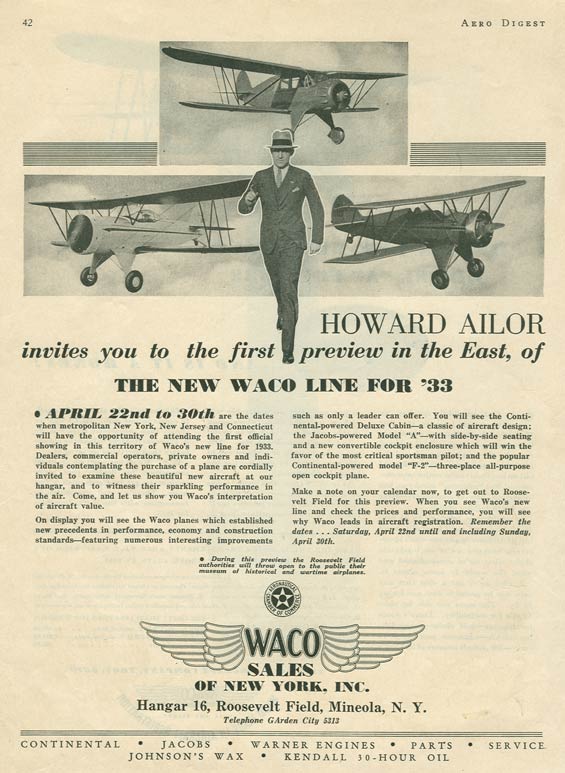 |
Note the mention of Johnson's Wax at the bottom of this ad. The Waco NC8584 was owned and flown by the Johnson's Wax Company. Below, another ad for Ailor's business.
Howard Ailor Sales Corporation, Ca. 1933 (Source: Heins)
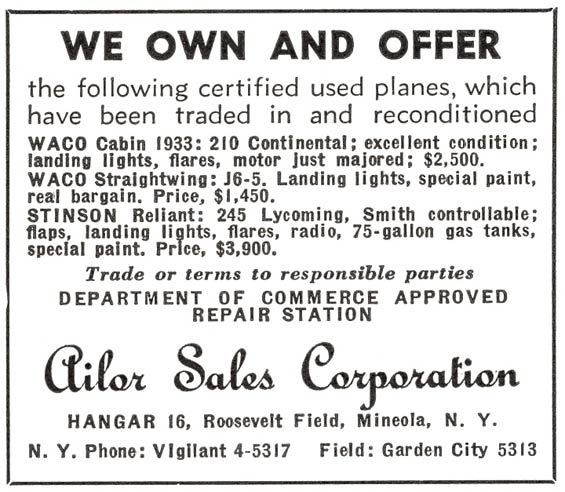 |
Below, another print ad from 1934. These ads would be full-page in the flying publications of the day.
Howard Ailor, Waco Dealer, Ca. 1934 (Source: Heins)
 |
The Daily Independent, Massillon, OH, April 9, 1931 (Source: Web)
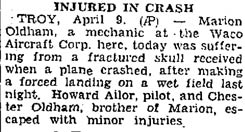 |
Earlier, in 1929, Ailor accompanied the Ford Reliability Tour in a Waco that was described simply as "Waco Service Ship." He was not competing; simply acting as support for the Waco team. First and second places that year were taken by Waco aircraft.
A couple of years later he made an Ohio newspaper, left, as a victim of a forced landing. We can assume the airplane was a Waco. The Waco factory was in Troy, OH.
A yuletide forced landing on the campus of Adelphi College moved a student poet to doggerel as in the poem below published in the Adelphi Fortnightly of December 18, 1935.
Adelphi College Fortnightly, December 18, 1935 (Source: Web)
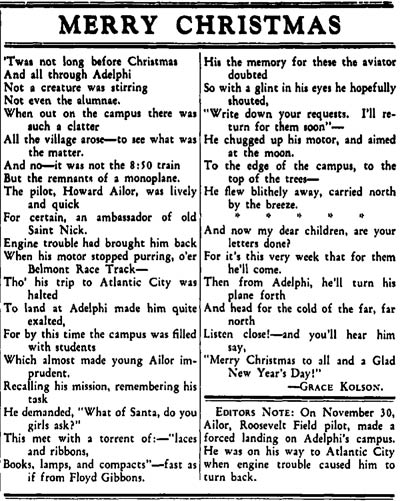 |
The Evening Tribune, Marysville, OH, March 20, 1941 (Source: Web)
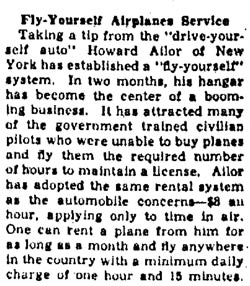 |
Ailor himself was an inventor and entrepreneur of sorts. An article in the December, 1940 Popular Mechanics describes a timer clock placed in the cockpit of an airplane that measured elapsed time only when the engine was turning. The clock was valuable for automatically, and fairly, logging usage times for rental airplanes. Modern pilots might visualize the Hobbs meter, which serves the same purpose. But this unit was five inches in diameter. The article, right, from Marysville, OH, describes the use to which he put his recording device.
Baldwinsville, NY, Gazette & Farmers' Journal, September 12, 1940 (Source: Web)
 |
Another article, left, from the Baldwinsville, NY Gazette and Farmers' Journal for September 12, 1940 goes into more details about Ailor's airplane rental business. Note in the last paragraph the mention of Lear Avia, passenger Bill Lear's company that manufactured aviation transceivers.
Later, in the late 1940s and 1950s, Ailor entered into coin-operated vending machine rentals. His company, Ascovend, of which he was president, acted as a clearing house to lease machines to individual route sales personnel. These individuals were associate operators and shared expenses and profits with Ascovend.
He was also an executive for the Hamilton Scale Company, eventually becoming president of that organization, too. They specialized in weighing machines -- penny scales-- that were placed in busy places like train stations, drug stores and the like. Some of the scales had paper strip feeders that dispensed advertising to people who used them. The advertising was another income stream for associates. Ailor mused that advertising for "dietary products" would be appropriate. Ailor has a United States patent on file for a "Design for a Weighing Machine" dated April 5, 1948.
Eventually, the output of Hamilton was completely funneled into Ascovend for distribution and placement. Postage stamp vending machines were added to the mix in 1954, with machines that could vend eight different stamps through the same slot.
Later, in The Billboard for October 1, 1955, Ailor is cited as the co-designer of a subway token and change machine marketed by Hamilton to the New York City Subway Authority. It was touted as doing, "... about everything but direct passengers in the Times Square Shuttle." It accepted any combination of nickels, dimes or quarters and dispensed the appropriate number of 15-cent tokens and the appropriate change.
I have no information about pilot Ailor's personal life, marriage, children, or recreational interests outside of work. If you know any of this information, please contact me through the link at the top of the right sidebar.
---o0o---
THIS PAGE UPLOADED: 01/05/12 REVISED:
|








